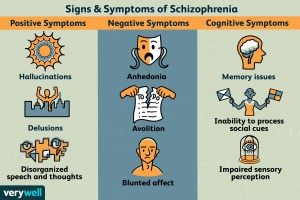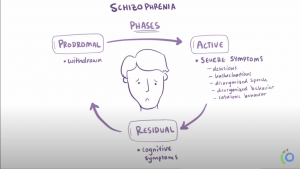Signs and Symptoms of Schizophrenia can be categorized into three categories (Positive, Negative, and Cognitive). Below is a great diagram of the difference between these categories.
Positive
- Delusions
- firm beliefs not supported by objective
- Delusion of control: something/someone is controlling them
- Delusion of reference: the statements made on TV or the radio are directed towards them
- Paranoia
- Changed perceptions
- Vision
- Hearing
- Smell
- Touch
- Taste
- Hallucinations
- hearing voices or seeing things
- Disorganized speech and behavior
Negative
- “Flat Affect”
- no expressed emotions or facial expressions. Monotone voice
- Alogia
- no real content within their speech
- When answering questions the individual will respond with simple answers such as “Yes” or “No” without further explanation or reasoning.
- Anhedonia
- decreased feeling pressure or anxiety
- Avolition
- decrease in motivation
- Difficulty planning, beginning and sustaining activities
- Lack of enjoyment in daily activities
- Social withdrawal
Cognitive
- Difficulty with
- Attention
- Concentration
- Memory
- Processing info to make decisions
- Using info after learning it
- Focusing

https://www.nimh.nih.gov/health/topics/schizophrenia
Males tend to show signs and symptoms in their late adolescence to early 20’s. While females tend to show signs and symptoms in their late 20’s to early 30’s.
Symptoms occur in an organized cycle. The majority of individuals will experience their symptoms in order. It is very rare that symptoms will be presented in a different order.
- Prodromal
- Socially withdraws
- Active
- delusions
- hallucinations
- loss of motivation
- displayed changes in speech
- displayed changes in behavior
- Residual
- Difficulty with
- Attention
- Concentration
- Memory
- Focusing
- Processing info to make decisions
- Using info after learning it
- Difficulty with
Below is a screenshot from a great video describing what Schizophrenia is and how it is caused.
 https://www.youtube.com/watch?v=PURvJV2SMso
https://www.youtube.com/watch?v=PURvJV2SMso
Vocabulary
- Positive symptoms: additions to normal processes
- Negative symptoms: removal of normal processes
- Signs: characteristics that can be observed by another person such as temperature and behavior
- Symptoms: characteristics that are only observant/felt by the individual such as taste, smell, vision, hearing
Representation of Schizophrenia in the media:
- Fight Club (1999)
- A Beautful Mind (2001)
- The Soloist (2009)
- Shutter Island (2010)
- Joker (2019)
- Fear of Rain (2021)
It is important to research from trusted resources whether the movie or television show portrays the illness accurately. Examples of unrealistic representation would be the movie Split (2016) and Black Swan (2010) which are both listed on Google’s search page under “Movies about Schizophrenia”. Individuals with Schizophrenia are not able to change the state or chemistry of their bodies as Kevin in Split was seen to do. According to psychiatrist Nadine Kaslow who is vice-chair to the psychiatry department at Emory University in Atlanta, Georgia, Nina in Balck Swan showed symptoms of Psychosis rather than Schizophrenia. Below is a visual describing the difference between Psychosis and Schizophrenia. Psychosis is series of episodes in which an individual loses touch with reality rather than a disease itself. https://abcnews.go.com/Health/Movies/black-swan-psychiatrists-diagnose-natalie-portmans-portrayal-psychosis/story?id=12436873
:max_bytes(150000):strip_icc()/psychosis-vs-schizophrenia-5095195_final-42cb304e269948519136e8f0f4cdc0da.jpg) https://www.verywellhealth.com/psychosis-vs-schizophrenia-5095195
https://www.verywellhealth.com/psychosis-vs-schizophrenia-5095195
Summary of In-Class Article
The article discussed the roles of Wnt and GSK3 signaling pathways in individuals with Schizophrenia. Wnt signaling disruption is being studied and used to create treatments for the illness in antipsychotics and lithium medications. The GSK3 gene is being studied as it is seen to decrease Wnt signaling and inhibit AKT.
